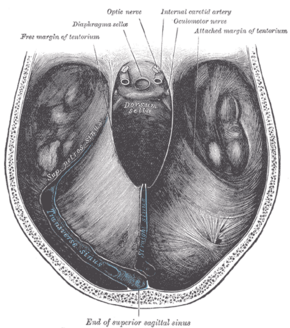Biology:Tentorial incisure
| Tentorial Incisure | |
|---|---|
 Tentorial incisure seen from above. An easy description is simply the hole created by the tentorium cerebelli | |
| Details | |
| Part of | tentorium cerebelli |
| Anatomical terms of neuroanatomy | |
Tentorial incisure (also known as the tentorial notch or incisura tentorii) refers to the anterior opening between the free edge of the tentorium cerebelli and the clivus for the passage of the brainstem.[1][2]
Structure
The tentorial incisure is located between the tentorial edges and communicates the supratentorial and infratentorial spaces. This area can be divided into three spaces: anterior, middle (lateral to), and posterior to the brainstem. The middle incisural space is close to the midbrain and the upper pons at the level of the pontomesencephalic sulcus. Medial temporal lobe structures such as the uncus, the parahippocampal gyrus and the hippocampal formation, are also intimately related to the incisura. The principal vascular structures coursing along the middle incisural space are the posterior cerebral artery and the superior cerebellar artery which pass around the brainstem, parallel to the free tentorial edge. The incisura has also a close relationship with the first 6 cranial nerves.[3]
Clinical significance
If Intracranial pressure superior to the tentorium cerebelli is increased, it may force part of the temporal lobe through this notch. This is referred to as a tentorial brain herniation. The consequences are unconsciousness, widening of the pupil of the affected side, and hemiparesis on the opposite side.
References
- ↑ "Incisura tentorii: Definition with Incisura tentorii Pictures and Photos". lexic.us. http://www.lexic.us/definition-of/incisura_tentorii. Retrieved 2015-05-14.
- ↑ Lang, J. (2001). Skull Base and Related Structures: Atlas of Clinical Anatomy. Schattauer. p. 235. ISBN 9783794519477. https://books.google.co.uk/books?id=pkY-4NJrC0wC. Retrieved 2015-05-14.
- ↑ Rothon Jr AL. Tentorial incisura. Neurosurgery 2000;47(Suppl. 3):131–53.

